Deep Sky Objects (DSOs)
|
| |
Deep Sky Objects include Open Clusters, Globular
Clusters, Nebulae, Galaxies,
Double Stars and Variable Stars.
|
| |
|
|
|
 |
A loose group of a few dozen to a few thousand stars,
usually associated with clouds of gas and dust. All known open
clusters are, like our Sun, located relatively far from the galactic
center, in the galaxy's spiral arms; they consist of young stars, with
ages ranging from a few million to a few hundred million years
|
|

|
|
|
|
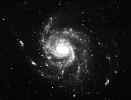
|
A densely packed sphere of several thousand to several
hundred thousand stars, held together by their mutual gravitation.
Nearly all globular clusters are relatively close to the center of our
galaxy. They have also been observed in other galaxies. In all
cases their stars seem to be billions of years old.
|
|

|
|
|
|
|
Nebulae are objects composed primarily of dust and
gas. Classes of Nebulae include Emission Nebulae, Reflection
Nebulae, Planetary Nebulae, supernova Remnants, and Dark Nebulae.
|
|
| |
|
Emission Nebulae
|
|
|
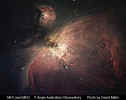 |
Emission Nebulae shine by internally produced
light. They are often the birthplaces of Stars |
|

|
|
Reflection Nebulae
|
|
|
 |
Reflection Nebulae shine by reflecting light
from nearby stars. Most are very faint. |
|

|
|
Supernova Remnants
|
|
|
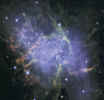 |
When a large star dies, the result is a
cataclysmic explosion, or supernova. The star is often completely
annihiliated or leaves behind a small pulsar. The gaseous and plasma
remnants slowly diffuse into space, becoming visible as twisted filaments
or nebulous blobs. |
|

|
|
Dark Nebulae
|
|
|
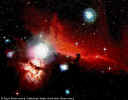 |
Dark Nebulae are regions of dust which
obscure stars or bright nebulae behind them. |
|

|
|
Planetary Nebulae
|
|
|
 |
Planetary nebulae are layers of gas which
have been shed by dying stars. They are often very small and difficult to
separate from other stars. |
|

|
|
|
|
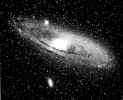 |
Any very large collection of stars outside of the Milky
Way. Galaxies are classified as spherical, Elliptical, Spiral,
Barred Spiral, and Irregular.
|
|

|
|
|
|
 |
Any two stars whose positions (as seen from Earth) are
very close. Doubles are classified as visual doubles if the
closeness is only apparent due to the stars lying in almost the same
direction from Earth and true doubles or Binary Stars
|
|
| |
| Easy-Find DSOs |
Intermediate-Find DSOs |
Hard-Find DSOs |
| Object |
Type |
| M42/M43 |
Diffuse Nebula |
| M31 |
Galaxy |
| M13 |
Globular Cluster |
| NGC 869/884 |
Double Open Cluster |
| M81/M82 |
Galaxy Pair |
| M98, M99, M88 |
Trio of Galaxies |
| M22 |
Globular Cluster |
| M104 |
Galaxy |
| M17 |
Diffuse Nebula |
| M57 |
Planetary Nebula |
|
| Object |
Type
|
|
NGC 7331
|
Galaxy
|
|
NGC 253
|
Galaxy
|
|
M1
|
Supernova Remnant
|
|
M77
|
Seyfert Galaxy
|
|
M27
|
Planetary Nebula
|
|
M87
|
Elliptical Galaxy
|
|
M64
|
Spiral Galaxy
|
|
M20 & M8
|
Diffuse Nebulae
|
|
M30 & M75
|
Globular Clusters
|
|
M51
|
Spiral Galaxy
|
|
| Object |
Type |
|
3C 273
|
Quasar
|
|
Stephan's Quintet
|
Galaxy Cluster
|
|
NGC 7479
|
Galaxy
|
|
M74
|
Galaxy
|
|
NGC 7000
|
Diffuse Nebula
|
|
M33
|
Spiral Galaxy
|
|
NGC 891
|
Edge-On Spiral Galaxy
|
|
M101
|
Spiral Galaxy
|
|
NGC 4567/4568
|
Pair of Colliding Galaxies
|
|
NGC 4038/4039
|
Pair of Colliding Galaxies
|
|
|
Messier Catalog
|
 During
the years from 1758 to 1782 Charles Messier, a French astronomer, compiled a
list of approximately 100 diffuse objects that were difficult to distinguish
from comets through the telescopes of the day. Messier's Catalog became well
known as a collection of the most beautiful objects in the sky including
nebulae, star clusters, and galaxies. It was one of the first
comprehensive list of Deep Sky Objects. The study of these objects by
astronomers has led, and continues to lead, to important discoveries such as the
life cycles of stars, the reality of galaxies as separate 'island universes,'
and the possible age of the universe. During
the years from 1758 to 1782 Charles Messier, a French astronomer, compiled a
list of approximately 100 diffuse objects that were difficult to distinguish
from comets through the telescopes of the day. Messier's Catalog became well
known as a collection of the most beautiful objects in the sky including
nebulae, star clusters, and galaxies. It was one of the first
comprehensive list of Deep Sky Objects. The study of these objects by
astronomers has led, and continues to lead, to important discoveries such as the
life cycles of stars, the reality of galaxies as separate 'island universes,'
and the possible age of the universe. |
 The Pages of The Gray Wizard
The Pages of The Gray Wizard